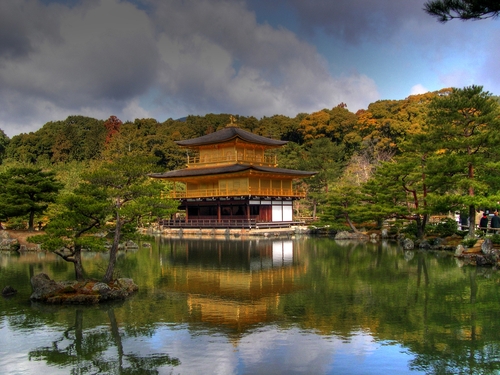Dangerous levels of radiation escaped a quake-stricken nuclear power plant after one reactor's steel containment structure was apparently breached by an explosion, and another reactor building in the same complex caught fire, Japan's leaders told a frightened population. Authorities warned that people within 20 miles of the crippled reactors should stay indoors to avoid being sickened by radiation.
The fast-moving developments at the Fukushima No. 1 (Daiichi) plant, 150 miles north of Tokyo, catapulted the 4-day-old nuclear crisis to an entirely new level, threatening to overshadow even the massive damage and loss of life spawned by a devastating earthquake and tsunami.
Prime Minister Naoko Kan, in a nationwide address to the Japanese people, called for calm even as he acknowledged the radiation peril. Dressed in industrial-style blue coveralls, he offered solemn assurances that authorities were doing "everything we can" to contain the leakage.
"There is a danger of even higher radiation levels," he said — chilling words to a nation where the atomic bombings of Hiroshima and Nagasaki in the waning days of World War II are known to every schoolchild. Slightly elevated radiation was detected in Tokyo, but not at health-affecting levels, officials said.
Cabinet Secretary Yukio Edano, speaking shortly afterward, said radiation levels around the plant's six reactors had climbed to the extent that "without a doubt would affect a person's health." But he insisted that outside the existing 12-mile evacuation zone, there was little or no health danger.
But people anywhere close to the plant were told to turn off ventilators drawing air from outdoors and not to hang laundry in the open air in order to avoid contamination.
The announcements, more than 12 hours after the situation at the Unit 2 reactor at the Fukushima plant began to deteriorate with the exposure of its fuel rods to air, heightening the threat of meltdown, generated anger and fear in the earthquake-affected area and beyond. Many Japanese do not believe that either the government or the plant's operator, Tokyo Electric Power Co., have been forthcoming about the extent of the danger amid a series of malfunctions at Fukushima.
The mayor of a small city that falls partly within the evacuation zone offered an unusually harsh public critique of the utility and Kan's administration.
"The government and Tokyo Electric Power have neglected to update residents with accurate information," Kazunobu Sakurai, the mayor of Minamisoma, told the public broadcaster NHK. "We need the government to keep us informed, to send emergency supplies and to help move residents who are inside the evacuation zone."
The explosion followed an early-morning acknowledgment from Tokyo Electric Power that, because of human error, the fuel rods inside the Unit 2 reactor had been at least partly exposed to air for more than two hours during two separate incidents the previous evening, allowing them to heat up and causing a buildup of explosive hydrogen gas. Independent experts said it was a grave development that heightened the risk of an uncontrolled release of radiation into the environment.
Authorities also disclosed that a fire broke out at the complex' Unit 4, which was later reported to have been extinguished.
The U.S. government mobilized emergency resources to help Japan grapple with the developing nuclear crisis, dispatching a team of Nuclear Regulatory Commission experts late Monday, activating an atmospheric radioactivity monitoring center at Lawrence Livermore National Laboratory in the Bay Area and rushing additional Navy ships to the region.
In the best-case scenario, the situation at the damaged reactors will take weeks, if not months, to stabilize, U.S. nuclear experts said.
"They do not have the situation under control," said Robert Alvarez, a nuclear expert at the Institute for Policy Studies and a former Energy Department official.
The company's acknowledgement that a "suppression pool" at the bottom of Unit 2, designed to serve as a last line of defense against a meltdown, was believed to have been breached could represent a major escalation of the crisis, said Victor Gilinsky, a former member of the Nuclear Regulatory Commission.
"If that is true, then there is a path to the control room, the workers and the outside environment," he said.
The cooling problems at Unit 2 represent the most serious development yet in the crisis at the plant, said nuclear specialist Edwin Lyman of the Union of Concerned Scientists.
When the fuel rods get too hot and react with water, they produce hydrogen gas that vents from the reactor into the containment building. When enough hydrogen accumulates, it becomes explosive. Containment buildings around two other reactors at the Fukushima complex already suffered explosions, on Saturday and Monday.
The fast-moving developments at the Fukushima No. 1 (Daiichi) plant, 150 miles north of Tokyo, catapulted the 4-day-old nuclear crisis to an entirely new level, threatening to overshadow even the massive damage and loss of life spawned by a devastating earthquake and tsunami.
Prime Minister Naoko Kan, in a nationwide address to the Japanese people, called for calm even as he acknowledged the radiation peril. Dressed in industrial-style blue coveralls, he offered solemn assurances that authorities were doing "everything we can" to contain the leakage.
"There is a danger of even higher radiation levels," he said — chilling words to a nation where the atomic bombings of Hiroshima and Nagasaki in the waning days of World War II are known to every schoolchild. Slightly elevated radiation was detected in Tokyo, but not at health-affecting levels, officials said.
Cabinet Secretary Yukio Edano, speaking shortly afterward, said radiation levels around the plant's six reactors had climbed to the extent that "without a doubt would affect a person's health." But he insisted that outside the existing 12-mile evacuation zone, there was little or no health danger.
But people anywhere close to the plant were told to turn off ventilators drawing air from outdoors and not to hang laundry in the open air in order to avoid contamination.
The announcements, more than 12 hours after the situation at the Unit 2 reactor at the Fukushima plant began to deteriorate with the exposure of its fuel rods to air, heightening the threat of meltdown, generated anger and fear in the earthquake-affected area and beyond. Many Japanese do not believe that either the government or the plant's operator, Tokyo Electric Power Co., have been forthcoming about the extent of the danger amid a series of malfunctions at Fukushima.
The mayor of a small city that falls partly within the evacuation zone offered an unusually harsh public critique of the utility and Kan's administration.
"The government and Tokyo Electric Power have neglected to update residents with accurate information," Kazunobu Sakurai, the mayor of Minamisoma, told the public broadcaster NHK. "We need the government to keep us informed, to send emergency supplies and to help move residents who are inside the evacuation zone."
The explosion followed an early-morning acknowledgment from Tokyo Electric Power that, because of human error, the fuel rods inside the Unit 2 reactor had been at least partly exposed to air for more than two hours during two separate incidents the previous evening, allowing them to heat up and causing a buildup of explosive hydrogen gas. Independent experts said it was a grave development that heightened the risk of an uncontrolled release of radiation into the environment.
Authorities also disclosed that a fire broke out at the complex' Unit 4, which was later reported to have been extinguished.
The U.S. government mobilized emergency resources to help Japan grapple with the developing nuclear crisis, dispatching a team of Nuclear Regulatory Commission experts late Monday, activating an atmospheric radioactivity monitoring center at Lawrence Livermore National Laboratory in the Bay Area and rushing additional Navy ships to the region.
In the best-case scenario, the situation at the damaged reactors will take weeks, if not months, to stabilize, U.S. nuclear experts said.
"They do not have the situation under control," said Robert Alvarez, a nuclear expert at the Institute for Policy Studies and a former Energy Department official.
The company's acknowledgement that a "suppression pool" at the bottom of Unit 2, designed to serve as a last line of defense against a meltdown, was believed to have been breached could represent a major escalation of the crisis, said Victor Gilinsky, a former member of the Nuclear Regulatory Commission.
"If that is true, then there is a path to the control room, the workers and the outside environment," he said.
The cooling problems at Unit 2 represent the most serious development yet in the crisis at the plant, said nuclear specialist Edwin Lyman of the Union of Concerned Scientists.
When the fuel rods get too hot and react with water, they produce hydrogen gas that vents from the reactor into the containment building. When enough hydrogen accumulates, it becomes explosive. Containment buildings around two other reactors at the Fukushima complex already suffered explosions, on Saturday and Monday.



















![Riyo Mori [Miss Universe 2007]](http://images6.fanpop.com/image/photos/34100000/Riyo-Mori-Miss-Universe-2007-japan-34113920-327-500.jpg)
![Maria Kamiyama [Miss Universe Japan 2011]](http://images6.fanpop.com/image/photos/34100000/Maria-Kamiyama-Miss-Universe-Japan-2011-japan-34113910-333-500.jpg)




